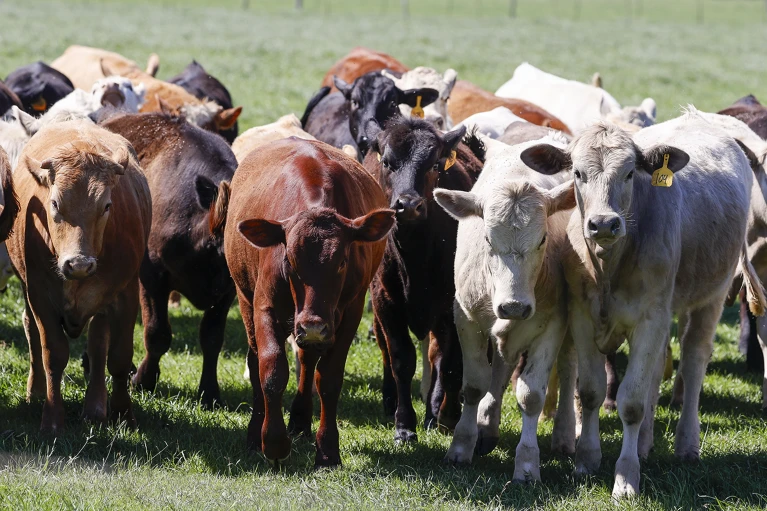A bird flu pandemic with the potential to be “100 times worse than COVID” may be on the horizon after a rare human case was discovered in Texas, experts have warned.
The H5N1 avian flu has spread rapidly since a new strain was detected in 2020, affecting wild birds in every state, as well as in commercial poultry and backyard flocks.
But it has now even been detected in mammals, with cattle herds across four states becoming infected, and on Monday, federal health officials announced that a dairy worker in Texas caught the virus.
“This virus [has been] on the top of the pandemic list for many, many years and probably decades,” Dr. Suresh Kuchipudi, a bird flu researcher from Pittsburgh, said at a recent panel discussing the issue, according to the Daily Mail.
“And now we’re getting dangerously close to this virus potentially causing a pandemic.”
He noted that the H5N1 virus has already been detected in species throughout the world and “has shown the ability to infect a range of mammalian hosts, including humans.”
“So therefore, in my view, I think this is a virus that has the greatest pandemic threat [that is] playing out in plain sight and globally present,” Kuchipudi said.
John Fulton, a pharmaceutical industry consultant for vaccines and the founder of Canada-based BioNiagara who organized the meeting, also expressed his concerns, the Mail reports.
“This appears to be 100 times worse than COVID — or it could be if it mutates and maintains its high case fatality rate,” he said.
“Once it’s mutated to infect humans, we can only hope that the [fatality rate] drops.” --->READ MORE HERE
 |
| Credit: Adam Davis/EPA-EFE/Shutterstock |
Researchers are closely monitoring the spread of a worrisome strain of avian influenza to cattle — and one person — at farms in six US states.
These infections represent the first widespread outbreak of bird flu in cows. The outbreak is concerning because humans frequently come into contact with cattle on farms, giving the virus ample opportunity to spread to people, says Daniel Goldhill, an evolutionary virologist at the Royal Veterinary College in Hatfield, UK.
Health officials have said that the overall threat to people remains low, for now, but they are watching the situation unfold closely. “There’s always a worry that viruses will surprise us,” Goldhill says. “We don’t know what they’ll do next.”
Scientists are scrambling to assess how well candidate vaccines and antiviral drugs will work against the circulating strain and to update diagnostic kits for identifying infections in people quickly. They are also trying to understand whether the cows were infected by birds or another source, and are on alert for any changes in the situation that could raise the risk for people.
“There are a lot of questions and, so far, not a lot of answers,” says Florian Krammer, a virologist at Icahn School of Medicine at Mount Sinai in New York City.
Where was the virus found previously, and what’s happening now?
In 1996, the influenza strain called H5N1 was first detected in birds in China. It has been spreading ferociously in birds since 2021, killing hundreds of millions of domestic and wild birds around the world. It has also occasionally infected mammals, including seals and bears, which have become “accidental hosts” of what is mostly an avian virus, says Kanta Subbarao, director of the World Health Organization (WHO) Collaborating Centre for Reference and Research on Influenza in Melbourne, Australia.
In the past two weeks, health officials have detected H5N1 in cows from 16 herds across six states — a number that is likely to increase as US surveillance is stepped up. Researchers have previously documented1 sporadic infections of cows with flu viruses closely related to H5N1, but no widespread outbreaks had been detected until now.
The more mammalian species the virus infects, the more opportunities it has to evolve a strain that is dangerous to humans, Goldhill says. One dairy worker in Texas has been infected, but the US Centers for Disease Control and Prevention (CDC) reports that the person is recovering. The worker’s only symptom was eye inflammation, and viral levels in their nose were low, suggesting that they don’t have a respiratory infection, according to the CDC.
The virus infecting the worker is closely related to the strains found in dairy cattle in Texas, with one notable distinction: the worker’s variant has a mutation that is linked to more-efficient spread in mammals. Goldhill says the presence of the mutation in the human sample was not surprising; it has appeared many times, including in foxes2 and cats3 infected with H5N1.--->READ MORE HEREFollow links below to relevant/related stories and resources:
Long Covid may be the body trying to fight off other viruses
Reported coronavirus cases continue to decline
USA TODAY: Coronavirus Updates
WSJ: Coronavirus Live Updates
YAHOO NEWS: Coronavirus Live Updates
NEW YORK POST: Coronavirus The Latest
If you like what you see, please "Like" and/or Follow us on FACEBOOK here, GETTR here, and TWITTER here.


No comments:
Post a Comment